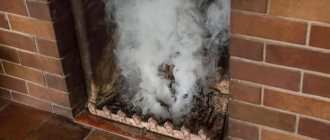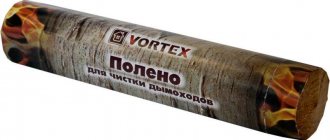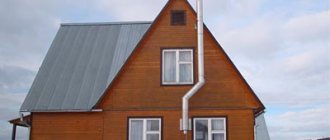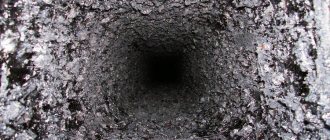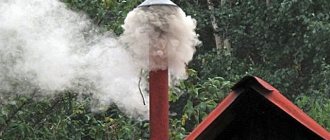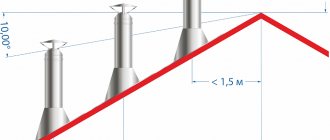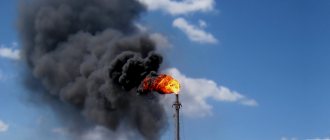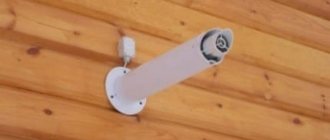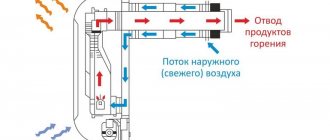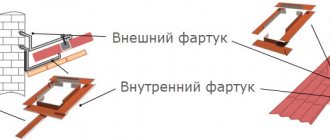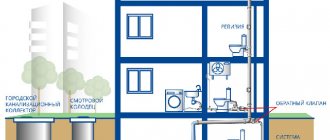There are two ways to clean a chimney from soot with your own hands - mechanical and chemical. In the first case, a brush is used. It is placed in the canal and deposits are removed from the inner walls. This cannot always be done. Access to the channel must be provided. It is desirable that it be straight. Turns, horizontal sections and changes in section make work difficult, sometimes making it impossible. The second option is active reagents. They are placed in the stove firebox on burning wood. The released gas softens the solid sediment. Some of it turns into a gaseous state, and some crumbles. This method is well suited for prevention at home to avoid large blockages. It won't cope with a thick layer. Over time, soot merges with the inner surface, filling microcracks and pores in brickwork or reinforced concrete. You have to remove it manually. Folk remedies are still used today. Despite their simplicity, they allow you to quickly deal with plaque.
Damage from a clogged chimney
Soot and soot particles are harmful to humans and have a negative impact on health. Regular inhalation of soot by a person can provoke pulmonary diseases, the appearance of chronic bronchitis, and exacerbation of other chronic diseases. Soot can cause ischemia.
Attention! Soot in the air is especially dangerous for pregnant women and children. The constant presence of soot in the air can cause negative consequences, including mutations and all kinds of organ defects.
Mechanical soot removal technology
The most effective method to quickly bring a chimney back to normal is mechanical cleaning. The work is labor-intensive and requires the performer to comply with a number of rules.
Chimney sweep tools and equipment
Chimney cleaning devices used many years ago are still relevant today.
Indicative list:
- A metal brush with a diameter 20-30% larger than the cross-section of the chimney. For square pipes, a stiff brush is selected.
- Cable and brush holders.
- Steel round core with cable and carabiner. The diameter of the weight is 2/3 of the chimney section.
For cleaning, it is better to choose a brush with nylon hard bristles.
Polyamide bristles take the shape of the channel, and unlike a metal scraper, do not scratch the internal walls of the chimney. The high flexibility of nylon helps to get rid of plaque in hard-to-reach areas of the chimney
Before doing dirty work, you need to take care of personal protective equipment - wear long sleeves, glasses, a respirator and gloves, and put on boots with non-slip soles.
Working Conditions: Basic Safety
It is important to take the following precautions during the cleaning process:
- The inspection hatches of the chimney must be closed so that soot does not get inside the room and spoil the finish. Cover the open fireplace with a damp cloth.
- Work is carried out in calm, dry weather.
- Be sure to use a safety rope and belt.
- It is advisable to enlist the support of one responsible assistant.
- It is strictly forbidden to start cleaning while drunk, tired, or after taking medications that slow down the reaction.
It is necessary to inspect the chimney in advance for the presence of foreign objects, for example, bird nests.
If the socket is low, then it needs to be pushed in the direction of the combustion chamber. A high-positioned object can be reached from above
Step-by-step process of chimney cleaning
The whole process consists of several steps:
- Remove the pipe head from the top of the chimney and use a broom or long stick to remove visible dirt.
- Perform a test run with a weighting agent. The core should split large layers - small fragments will fall into the firebox.
- When the patency of the canal is restored, pull out the cable and connect the brush to the core.
- Clear a small area by lowering and raising the rope.
- Clean the rest of the chimney in the same way.
- Check the inspection chamber and remove any fallen soot.
The described technology is effective for straight chimneys - even at an angle of 45°, the passage of the core will be difficult.
Multifaceted professional brushes on a flexible shaft are designed for cleaning chimneys, ventilation systems and sewers. Markings on the cable allow you to control the depth of passage
How often should a chimney be cleaned?
In order to avoid problems with clogging, it is necessary to regularly clean the chimney. The frequency of cleaning depends on several factors.
- Any stoves need pipe cleaning immediately after installation or repair.
- Equipment used during certain seasons should be cleaned before and after intensive use.
- Brick chimneys should be cleaned once every quarter.
- Gas equipment must be cleaned several times a year.
- Chimneys made from other materials should be cleaned at least once a year.
- Heating and cooking stoves require cleaning at least three times per season.
Causes of blockages and how to avoid them
There are only two reasons.
- Fumes from cooking. The amount of solid sediment depends on what is being cooked in the oven. Problems are caused by fumes from the boiler or grill grate. Steam, saturated with food particles, rises up along with the smoke, gradually cools and settles in the form of condensate. Drops penetrate the porous surface of brick and reinforced concrete, carrying their contents with them. They then go into a gaseous state, and a precipitate remains. A certain amount of particles settles upon contact with the walls.
- Soot that is formed during the natural operation of a fireplace and a gas boiler connected to the shaft. Its quantity increases noticeably due to low quality fuel and stove malfunctions. For the stove to work correctly, it is necessary to create normal draft. The strength of the flow depends on the height of the pipe and the temperature difference between inside and outside the room. To understand why this is so important, you need to remember the school course in physics and chemistry. Combustion is a process that cannot take place without oxygen. This gas is one of the main catalysts. A fire goes out if the flow of fresh air to it is blocked. If the height of the channel is insufficient or the cross-section is too small, oxygen flows in poorly. In such conditions, instead of a bright flame, slow smoldering occurs with the release of a large amount of smoke. To solve the problem, you will have to calculate the cross-section of the chimney, disassemble the structure and rebuild it properly.
Mechanical and manual cleaning
Materials and tools
Mechanical pipe cleaning has been known many centuries ago. Materials needed for manual cleaning:
- a special brush for cleaning the smoke channel;
- strong rope or flexible cable;
- metal hard brushes;
- metal weight (usually in the shape of a ball);
- metal scraper for removing stubborn stains.
A method for making cleaning equipment yourself
Some people prefer to clean the chimney from soot with their own hands. To do this, you need to prepare special equipment. You can make the same ruff with your own hands.
- To make it you will need a plastic bottle, from which you need to cut 150 ml of the top. Small cuts should be made along the top.
- You need to drill a hole in the center of the plug. Screw the stopper to the neck. Bend the resulting cuts like petals.
- Make a second bottle brush of the same type.
- You should also choose a suitable load. The weight of the load must be such that the brush can freely pass through the smoke channel.
- The selected load must be tied to a flexible cable or strong rope capable of supporting the weight of the load. Pass the end of the rope through the hole in the plug.
- Place the cut bottles one inside the other. Thus, you will get a bottle cylinder - a brush.
Cleaning the pipe from the roof side
Instructions on how to clean a chimney in the stove of a private house from the roof:
- Manual and mechanical cleaning can only be done in warm and dry weather. To prevent soot from entering the room, it is necessary to cover the firebox and hatches with a damp cloth.
- First you need to remove the head and inspect the smoke channel. If it is heavily soiled, you can sweep away the debris with a broom.
- Next, you need to lower the brush with an attached load into the smoke channel.
Tool set
A professional chimney sweep service is quite expensive, and the instructions are not so complicated for an amateur, so next we will try to analyze it step by step and start with the tool.
There are not many devices for such work, and the main one among them has been a chimney brush for hundreds of years. Previously, this instrument was exclusively metal, but now plastic models have appeared.
Of course, it’s easier to buy a professional chimney brush, but high-quality models are expensive, and there’s no point in spending money on consumer goods. A good solution would be to make your own chimney brush. To do this, you can use a hard plastic broom or assemble a brush from elastic steel wire.
Scheme of a homemade brush for cleaning a chimney
Plastic brush
It is easier to make a plastic brush; for this you will need a hard plastic broom, which can be bought at any hardware store, 2 repair nuts with a ring, a threaded rod and a couple of wide washers. Plus weighting and a cable, but more on that later.
Assembling a brush for cleaning a chimney with your own hands will be inexpensive
The assembly instructions themselves are not complicated.
- Remove the top cap from the broom.
- Drill a hole in the center of the broom.
- Insert a pin into this hole.
- Place 2 wide washers on both sides of the stud.
- Screw on 2 repair washers with a ring on both sides of the stud; screw until the broom bristles are pulled apart.
- Hang a cable on one side and a weight on the other.
Homemade plastic brush for cleaning the chimney
Metal brush
The metal brush is also easy to assemble; the instructions are almost the same. The location of the parts is shown in the diagram above. Only instead of a plastic broom, you need to take a thick steel cable, cut it and disassemble it, and then use steel wire to assemble the brush.
Metal brush on a prefabricated rod made of PVC pipes
Important! The ideal option for weighting is a metal core, but it can be replaced with any other weighting material, the main thing is that the device is well centered. If you hang a weight with a shifted or changed center of gravity, such as a dumbbell, then it may jam directly in the chimney and then you will have to disassemble part of the pipe.
Flexible models
A wire brush is considered the main tool, but it is not the only one. The photo above shows a prefabricated rod made of PVC pipes. If you know how to solder PVC pipes, then you can assemble the rod yourself, otherwise, contact the mechanics at the housing office.
On this site there is a separate article on arranging a plastic pipeline with your own hands, there are step-by-step soldering instructions with photos and videos, using it you can solder a typesetting rod yourself, all this is “HERE” .
But you can’t do everything with your own hands, I recommend buying a brush with a fiberglass cable, it will be useful when cleaning rough channels in the oven.
When cleaning the furnace channels, you cannot do without a brush on a flexible fiberglass cable.
Chemical cleaning
Naphthalene
This cleaning method is not suitable for fireplaces. Naphthalene must be applied to the surface of the fuel that residents are going to use to light the stove. When fired, naphthalene evaporates, and its vapors help destroy soot and plaque. The disadvantage of naphthalene cleaning is the sharp and specific smell.
Blue mixture
The composition of this mixture includes: 1/5 part of copper sulfate, 1/7 part of saltpeter and ½ part of medium fraction coke. The resulting product must be applied to the fuel. During the combustion process the mixture will dissolve. Vapors can destroy soot.
Log chimney sweep
This is a pipe cleaner that contains: carbon wax, phosphorus oxide, ammonium sulfate. The presented product is easy to use and removes accumulated soot well.
Kominichek
The basis of this powdered product is copper chloride. One package contains five sachets. Helps with minor blockages. After use, be sure to ventilate the room.
PHC
This abbreviation means “anti-carbon chemical composition”. Used for minor pipe blockages. PCPs should be burned without unpacking, directly in the bags.
Why clean the chimney?
For good traction
Soot settling on the walls of the chimney gradually narrows its lumen and prevents the free passage of smoke. In addition, a thick coating of soot does not allow the walls to warm up well, and this leads to a decrease in draft, smoke penetration into the room and a decrease in efficiency.
For safe use
At high temperatures, soot can ignite and cause the walls to crack, leading to failure. But that's not the worst thing. Flying sparks from burning soot can cause a fire. Poor draft can also have dire consequences, leading to carbon monoxide poisoning.
Features of biological treatment
Some homeowners are wondering how to clean a stove in their country house that smokes and smokes. There are mechanical, chemical and biological (also called folk) cleaning agents. The big advantage of biological cleaning is that it can be used in any weather.
There are three main and common methods of biological treatment: burning special means and products, using certain firewood as fuel, and sprinkling with salt.
Choosing firewood and cleaning the chimney are important aspects of operating a fireplace and stove
1. Optimal choice of firewood
2. Chimney cleaning: rules and secrets
3. How to determine if your chimney needs cleaning
Do we think about what kind of firewood is best to use to light a fireplace , home or sauna stove? In most cases, unfortunately, no. We choose whatever comes to hand first in the store, or we prepare it ourselves from trees that grow near the house. And this is not entirely correct.
When using wood heating appliances, the choice of firewood is of great importance. This determines not only the efficiency, but also how often the chimney will have to be cleaned. We will tell you about all this in this article.
Optimal choice of firewood
First, it’s worth determining what qualities good firewood should have. First of all, when burning they must release the maximum amount of heat. Secondly, you should consider the cost: some types of wood are so expensive that sometimes it is better to find a cheaper alternative.
Finally, it is important to understand the characteristics of each type of wood. After all, some give a wonderful aroma, others give a beautiful flame, and there are also those that leave a large layer of resin and burning in the chimney.
We offer some simple tips that will allow you not to make mistakes when choosing firewood.
The most common types of wood used for lighting stoves and fireplaces are:
- Poplar,
- Aspen,
- Birch,
- Ash,
- Pine.
The main advantage of poplar firewood is its cost. But even this “plus” will not cover the main disadvantage of such wood: a small amount of heat. The logs burn out very quickly and leave almost no coals.
Aspen is good not only for the firebox, as it burns well, smells nice and gives enough heat, but also for cleaning the chimney. Unfortunately, such wood is more expensive than other species and is not often on sale.
Birch firewood burns for a long time, gives good heat, but at the same time smokes quite strongly. Therefore, it is better not to use them in open-type heating equipment.
The main advantage of ash firewood is that it can be burned even in its raw form: it will not only burn well, but also give good heat.
And perhaps the best option is pine. It burns well, has high heat transfer, and has a pleasant aroma. But, like many other coniferous trees, pine contains resin, so you will have to clean both the chimney and the stove or fireplace a little more often.
Chimney cleaning: rules and secrets
80% of buyers select the wrong equipment. Leave a request for a FREE selection of a fireplace, stove, chimney taking into account all your parameters/needs. You will receive advice from a specialist who has been working in the furnace business for 15 years. AND 500 RUBLES AS A FREE!
No matter how great the firewood you choose is, you will still have to clean your chimney. This procedure is necessary in order to remove soot accumulated on the walls. Otherwise, it is possible not only to reduce the efficiency of the fireplace or stove, but also to ignite the accumulated combustion products.
Of course, chimney sweeps are the best ones to handle this. But are there ways to carry out prevention so as not to resort to their services very often? Of course have.
Traditional methods:
Proven means for preventing soot accumulation are salt and potato peelings. They are placed in the firebox, directly on top of the firewood. The released substances soften the soot, and it comes out along with the combustion products.
As we wrote above, aspen firewood is suitable for cleaning a chimney: it heats the walls of the chimney to high temperatures, and the soot begins to burn out.
Chemical compositions:
The modern market offers a large number of special products that help carry out preventive cleaning of the chimney. During combustion they are simply added to the fuel. Such compositions emit substances that are harmless to humans, which perfectly clean both the walls of the heating device or sauna stove itself, and the chimney.
Mechanical cleaning:
To do this, you can use specialized brushes, vacuum cleaners, and devices for cleaning the chimney from below. Or you can make a pipe cleaner yourself: cut a plastic bottle in many places from the bottom, and insert a rod into the neck.
How to determine if your chimney needs cleaning
So you've used your fireplace or stove for quite some time. Most likely, you may have experienced the first symptoms of soot accumulation on the walls of the pipe. But, unfortunately, many users know nothing about them.
The first indicator that it's time to call a chimney sweep is dark smoke. When the chimney is clean, the smoke is light, almost white.
Preventing blockages
To avoid frequent and severe blockages, you need to follow some recommendations:
- It is not recommended to use coniferous wood for burning, as it emits a lot of resin;
- You should not burn waste in a stove or fireplace other than the fuel intended for kindling;
- You need to light the stove with dry wood;
- Periodically you need to burn aspen or alder logs.
If you follow these recommendations, there should be no problems or questions about how to clean the stove from soot.
Using sandwich pipes
Sandwich pipe for chimney
However, stoves are used not only in residential buildings, but also in bathhouses. Recently, chimneys are often assembled from low-quality sandwich pipes, which are not insufficiently insulated, so condensation forms abundantly inside them, and when mixed with soot, it forms a tarry substance.
Video: a chimney made of sandwich pipes gets clogged
Video: which sandwich pipes should you buy to prevent condensation from forming in them?
We also must not forget that the formation of soot is influenced by the type of fuel used, but if everything is in order, then cleaning a chimney from sandwich pipes will not be a tedious task.
Safety precautions
How to clean soot from a stove while observing safety rules and conditions? Soot in the air has a very bad effect on the lungs, so when working with the stove and pipes, you must use protective equipment: gloves, goggles, and a nose bandage.
If you plan to perform mechanical cleaning on the roof, be sure to wear thick, stable shoes with solid soles. You cannot clean the roof in bad weather: rain, snow, wind.
After the cleaning is completed, the fallen soot must be removed: manually or using a vacuum cleaner. After treatment with chemicals, the room must be thoroughly ventilated.
Cleaning quality control
Now you know how and with what you can clean the chimney. Regardless of whether you did the cleaning yourself or it was done by specialists, the chimney after this procedure must be examined and, if necessary, minor repairs made.
Many people do not trust chemical cleaning methods precisely because no powder or magic log can guarantee the quality that a chimney sweep will give you. At the end of the work, a good specialist will definitely check the quality of cleaning and the condition of the chimney by lowering special mirrors into it.
Some advanced stove and fireplace service organizations use portable video cameras with built-in lighting for these purposes. Of course, such equipment is still rare, but if you really want it and enter into an agreement with such a company, you can personally control how well the chimney was cleaned - the video will show all its sections.
